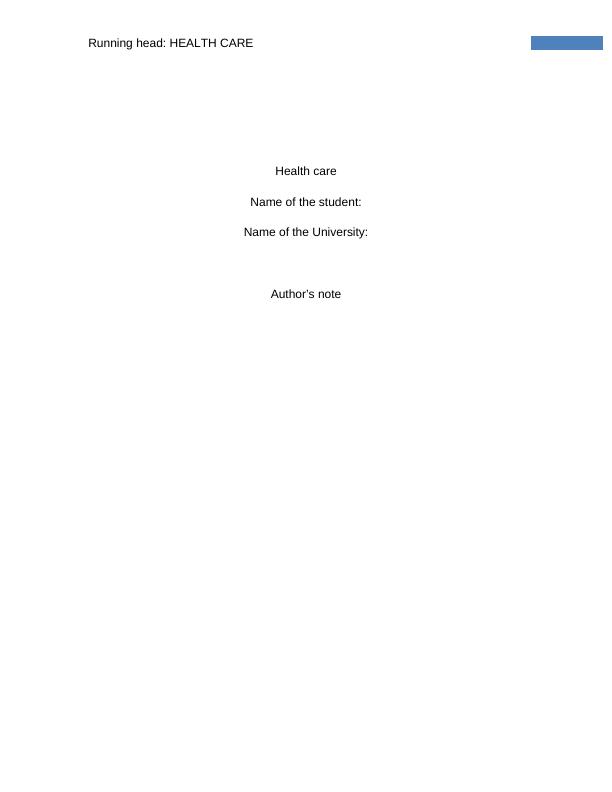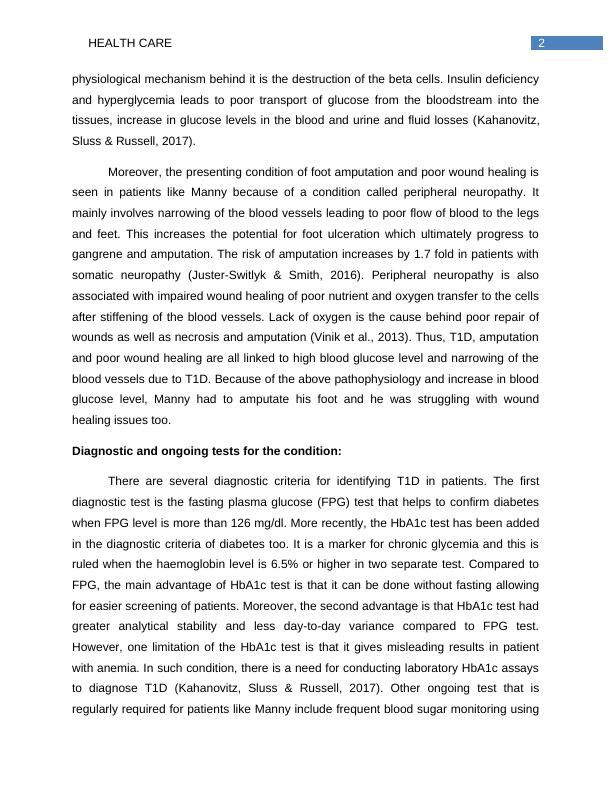Health Care | Written Case Analysis Essay
Added on 2022-09-13
8 Pages2333 Words12 Views
Running head: HEALTH CARE
Health care
Name of the student:
Name of the University:
Author’s note
Health care
Name of the student:
Name of the University:
Author’s note

1HEALTH CARE
Part A: Written case analysis essay
Introduction:
The main purpose of the essay is to analyze the case study of Manny, a 42 year
old man with type 1 diabetes who had his forefoot amputated. The presenting condition
for the client is poor wound healing post his forefoot amputation and the chronic
condition is history of type 1 diabetes. The essay will discuss about the pathophysiology
of this chronic condition and the presenting issue and explain about relevant diagnostic
and ongoing test linked to the patient’s condition. The essay will evaluate two potential
problems for patient and identify three nursing care priorities for the management of the
chronic and presenting condition. All health literacy and cultural consideration will be
discussed in the context of planning care for the patient too.
Symptom, anatomy, pathophysiology of the chronic and presenting condition:
This essay is focused on the case study of Manny whose presenting condition of
poor wound healing post forefoot amputation is seen because of Type 1 diabetes (T1D).
T1D is a chronic disease associated with clinical presentation of polydipsia (increase in
thirst), polyphagia (increased hunger) and polyuria (increased urination) along with
hyperglycemia. These symptoms are the diagnostic hallmarks in children and
adolescents. In case of adults, the common symptoms include feeling thirsty, fatigue,
loss of weight, blurred vision, urinating frequently and difficulty in breathing (Atkinson,
Eisenbarth & Michels, 2014). It is a condition that can be diagnosed at any age,
however the peak in presentation is mostly seen between 5-7 years of age (Kahanovitz,
Sluss & Russell, 2017). The main pathophysiology behind T1D is the alterations in the
immune producing hormone leading to autoimmune destruction of the insulin producing
beta cells. Another explanation is that in patient with this disease, pancreas lack insulin
producing cells and remaining beta cells are incapable of generating adequate amount
of insulin (Atkinson, Eisenbarth & Michels, 2014).. Thus, the body is not able to
produce adequate insulin to meet the overall needs. The main anatomic structure
affected by the condition is the insulin producing beta cells in the pancreas and the
Part A: Written case analysis essay
Introduction:
The main purpose of the essay is to analyze the case study of Manny, a 42 year
old man with type 1 diabetes who had his forefoot amputated. The presenting condition
for the client is poor wound healing post his forefoot amputation and the chronic
condition is history of type 1 diabetes. The essay will discuss about the pathophysiology
of this chronic condition and the presenting issue and explain about relevant diagnostic
and ongoing test linked to the patient’s condition. The essay will evaluate two potential
problems for patient and identify three nursing care priorities for the management of the
chronic and presenting condition. All health literacy and cultural consideration will be
discussed in the context of planning care for the patient too.
Symptom, anatomy, pathophysiology of the chronic and presenting condition:
This essay is focused on the case study of Manny whose presenting condition of
poor wound healing post forefoot amputation is seen because of Type 1 diabetes (T1D).
T1D is a chronic disease associated with clinical presentation of polydipsia (increase in
thirst), polyphagia (increased hunger) and polyuria (increased urination) along with
hyperglycemia. These symptoms are the diagnostic hallmarks in children and
adolescents. In case of adults, the common symptoms include feeling thirsty, fatigue,
loss of weight, blurred vision, urinating frequently and difficulty in breathing (Atkinson,
Eisenbarth & Michels, 2014). It is a condition that can be diagnosed at any age,
however the peak in presentation is mostly seen between 5-7 years of age (Kahanovitz,
Sluss & Russell, 2017). The main pathophysiology behind T1D is the alterations in the
immune producing hormone leading to autoimmune destruction of the insulin producing
beta cells. Another explanation is that in patient with this disease, pancreas lack insulin
producing cells and remaining beta cells are incapable of generating adequate amount
of insulin (Atkinson, Eisenbarth & Michels, 2014).. Thus, the body is not able to
produce adequate insulin to meet the overall needs. The main anatomic structure
affected by the condition is the insulin producing beta cells in the pancreas and the

2HEALTH CARE
physiological mechanism behind it is the destruction of the beta cells. Insulin deficiency
and hyperglycemia leads to poor transport of glucose from the bloodstream into the
tissues, increase in glucose levels in the blood and urine and fluid losses (Kahanovitz,
Sluss & Russell, 2017).
Moreover, the presenting condition of foot amputation and poor wound healing is
seen in patients like Manny because of a condition called peripheral neuropathy. It
mainly involves narrowing of the blood vessels leading to poor flow of blood to the legs
and feet. This increases the potential for foot ulceration which ultimately progress to
gangrene and amputation. The risk of amputation increases by 1.7 fold in patients with
somatic neuropathy (Juster-Switlyk & Smith, 2016). Peripheral neuropathy is also
associated with impaired wound healing of poor nutrient and oxygen transfer to the cells
after stiffening of the blood vessels. Lack of oxygen is the cause behind poor repair of
wounds as well as necrosis and amputation (Vinik et al., 2013). Thus, T1D, amputation
and poor wound healing are all linked to high blood glucose level and narrowing of the
blood vessels due to T1D. Because of the above pathophysiology and increase in blood
glucose level, Manny had to amputate his foot and he was struggling with wound
healing issues too.
Diagnostic and ongoing tests for the condition:
There are several diagnostic criteria for identifying T1D in patients. The first
diagnostic test is the fasting plasma glucose (FPG) test that helps to confirm diabetes
when FPG level is more than 126 mg/dl. More recently, the HbA1c test has been added
in the diagnostic criteria of diabetes too. It is a marker for chronic glycemia and this is
ruled when the haemoglobin level is 6.5% or higher in two separate test. Compared to
FPG, the main advantage of HbA1c test is that it can be done without fasting allowing
for easier screening of patients. Moreover, the second advantage is that HbA1c test had
greater analytical stability and less day-to-day variance compared to FPG test.
However, one limitation of the HbA1c test is that it gives misleading results in patient
with anemia. In such condition, there is a need for conducting laboratory HbA1c assays
to diagnose T1D (Kahanovitz, Sluss & Russell, 2017). Other ongoing test that is
regularly required for patients like Manny include frequent blood sugar monitoring using
physiological mechanism behind it is the destruction of the beta cells. Insulin deficiency
and hyperglycemia leads to poor transport of glucose from the bloodstream into the
tissues, increase in glucose levels in the blood and urine and fluid losses (Kahanovitz,
Sluss & Russell, 2017).
Moreover, the presenting condition of foot amputation and poor wound healing is
seen in patients like Manny because of a condition called peripheral neuropathy. It
mainly involves narrowing of the blood vessels leading to poor flow of blood to the legs
and feet. This increases the potential for foot ulceration which ultimately progress to
gangrene and amputation. The risk of amputation increases by 1.7 fold in patients with
somatic neuropathy (Juster-Switlyk & Smith, 2016). Peripheral neuropathy is also
associated with impaired wound healing of poor nutrient and oxygen transfer to the cells
after stiffening of the blood vessels. Lack of oxygen is the cause behind poor repair of
wounds as well as necrosis and amputation (Vinik et al., 2013). Thus, T1D, amputation
and poor wound healing are all linked to high blood glucose level and narrowing of the
blood vessels due to T1D. Because of the above pathophysiology and increase in blood
glucose level, Manny had to amputate his foot and he was struggling with wound
healing issues too.
Diagnostic and ongoing tests for the condition:
There are several diagnostic criteria for identifying T1D in patients. The first
diagnostic test is the fasting plasma glucose (FPG) test that helps to confirm diabetes
when FPG level is more than 126 mg/dl. More recently, the HbA1c test has been added
in the diagnostic criteria of diabetes too. It is a marker for chronic glycemia and this is
ruled when the haemoglobin level is 6.5% or higher in two separate test. Compared to
FPG, the main advantage of HbA1c test is that it can be done without fasting allowing
for easier screening of patients. Moreover, the second advantage is that HbA1c test had
greater analytical stability and less day-to-day variance compared to FPG test.
However, one limitation of the HbA1c test is that it gives misleading results in patient
with anemia. In such condition, there is a need for conducting laboratory HbA1c assays
to diagnose T1D (Kahanovitz, Sluss & Russell, 2017). Other ongoing test that is
regularly required for patients like Manny include frequent blood sugar monitoring using

End of preview
Want to access all the pages? Upload your documents or become a member.
Related Documents
Pamphlet for Type 1 Diabetes | Assignmentlg...
|5
|761
|13
Underlying Pathophysiology of Type 1 Juvenile Diabeteslg...
|5
|946
|496
Type II Diabetes: Pathophysiology, Causes, and Nursing Managementlg...
|11
|3177
|113
Type 1 Diabetes: Risk Factors, Aetiology, Pathophysiology, Clinical Manifestations, Diagnostic Tests, and Treatmentlg...
|4
|1883
|409
Diabetes Management Case Studylg...
|10
|3057
|65
Principles of Nursing: Surgicallg...
|11
|2904
|102
